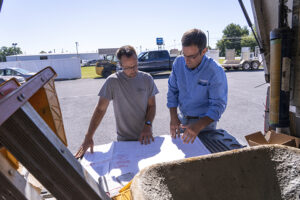Get Things Done: A 5-step Process
February 8, 2021 Productivity expert David Allen wrote a book called “Getting Things Done: The Art of Stress-Free Productivity.” Within it, Allen shares practical insight and tips that small-business owners and managers, including those in the building industry, can use to get things done more efficiently and cost-effectively. In our next several newsletters, we’ll break down Allen’s five-step process and share how you might apply them to your business as you juggle sales, bookkeeping, human resources, customer service, marketing, and the many other duties besides your building project work.
Productivity expert David Allen wrote a book called “Getting Things Done: The Art of Stress-Free Productivity.” Within it, Allen shares practical insight and tips that small-business owners and managers, including those in the building industry, can use to get things done more efficiently and cost-effectively. In our next several newsletters, we’ll break down Allen’s five-step process and share how you might apply them to your business as you juggle sales, bookkeeping, human resources, customer service, marketing, and the many other duties besides your building project work.
In this issue, we’ll begin with a high-level overview of Allen’s steps to productivity.
1. CAPTURE
This step involves getting your decision-making and to-do list out of your head and, instead, captured in some form or other that you can refer back to later. Doing so frees your mind to concentrate on the tasks at hand while keeping other priorities on your radar.
2. CLARIFY
This part of the process is unloading what you’ve captured on your list and determining what’s next. It involves reviewing your captured items and determining what you need to act upon (including details of what that will entail), what you can delegate, and what you can disregard.
3. ORGANIZE
This step is about keeping information in the correct spot so that it’s easy to access and ready for use at the right time. It involves sorting items into categories and containing them in some form, such as notebooks, a software application, physical file folders, or a calendar (if the items need your direct attention or have deadlines).
4. REFLECT
“Reflect” is about stepping back to review everything from a broader perspective. You’ve all heard the phrase “couldn’t see the forest for the trees.” Well, reflecting helps ensure you keep tabs on the fine details and the big picture. By regularly reviewing the items and notes that you’ve captured in your organizational system, you can avoid letting things slip through the cracks and clear out anything that may no longer be relevant.
 5. ENGAGE
5. ENGAGE
Productivity depends on putting effort into the right things at the right times. The engagement step involves judging what will be the best use of your available time. Sometimes, forging ahead with actions you planned and scheduled will be ideal. Other times, you may find it more important to tackle an unexpected problem. If items must get pushed aside, the first four steps ensure they remain in view and get attention later.
The Getting Things Done® (GTD) process is similar to building a deck. You don’t build a deck all at once; first, the footers are dug, then the frame is added, and then the decking is placed. These “to-dos” are broken down even further to make them manageable.
Stay tuned for our follow-up newsletters, which will dig deeper into how your business can improve productivity using Allen’s GTD steps!